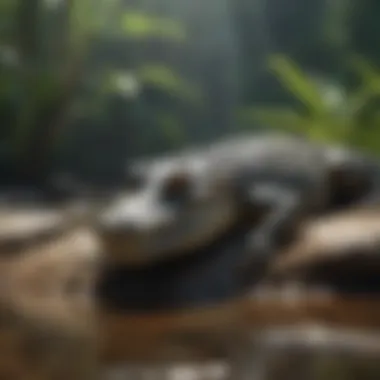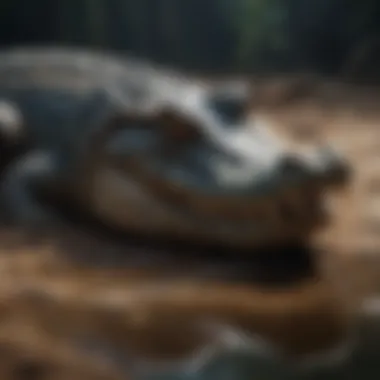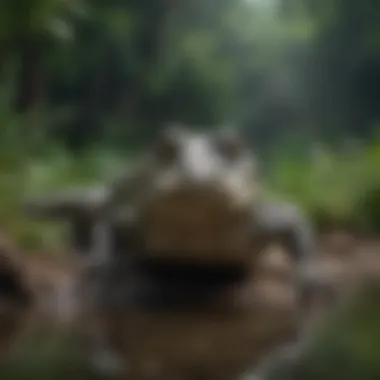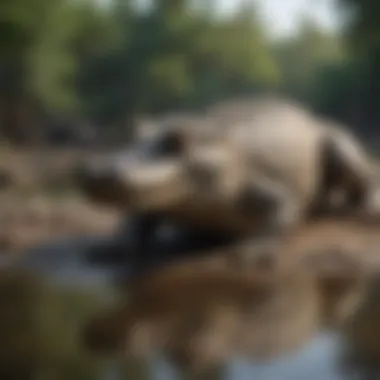Exploring the Smallest Crocodile Species on Earth


Intro
Crocodiles are complex and diverse reptiles, yet the smallest species among them often receive less attention. Understanding these small crocodiles reveals important insights into the ecological balance of their habitats. This section serves as an entry point into the study of the smallest crocodiles, exploring their classification, characteristics, and distribution.
Animal Overview
Common Name and Scientific Classification
The smallest crocodile species include the dwarf caiman (Paleosuchus palpebrosus) and the pygmy crocodile (Osteolaemus tetraspis). These species belong to the Crocodylidae family but differ in characteristics and habitats.
Physical Characteristics
Dwarf caimans typically grow to about 1.5 meters in length, while pygmy crocodiles can reach lengths of up to 1.2 meters. Their size contributes significantly to their stealth in hunting, allowing them to navigate through dense vegetation. The skin of these species is generally dark, providing effective camouflage in their natural habitats.
Habitat and Distribution
These small crocodiles are primarily found in freshwater environments, including swamps, rivers, and lakes. The dwarf caiman prefers slow-moving water bodies, often in areas rich with vegetation in South America, particularly the Amazon Basin. The pygmy crocodile resides mainly in the Central and West African wetlands. Such diverse habitats reflect their adaptability, allowing them to thrive in differing ecological niches.
Behavior and Social Structure
Communication Methods
Small crocodiles utilize a range of vocalizations for communication. They produce hisses during territorial displays and grunts when they interact with other individuals. These sounds help maintain social connections in their often solitary lives.
Social Hierarchies
Despite being primarily solitary, some small crocodiles exhibit social behaviors during breeding seasons. Males establish dominance through ritual displays, often flexing their bodies to demonstrate size and strength.
Mating and Reproductive Behavior
Breeding typically occurs during the rainy season. Females construct nests on elevated ground, laying approximately 10 to 20 eggs. Both species exhibit parental care, a rarity among reptiles, as they guard nests until the eggs hatch and help their young to water.
Conservation Status
Current Population Trends
Data indicates that populations of small crocodiles are stable, although they face pressure from habitat destruction. Ongoing research is vital for understanding future trends.
Threats and Challenges
These species contend with several threats, including habitat loss due to agriculture and urban expansion. Also, illegal hunting poses a risk to their survival in certain regions. Conservation efforts are essential to mitigate these threats and ensure long-term sustainability.
Conservation Efforts and Success Stories
Organizations have initiated protective measures for the habitats of small crocodiles. Community awareness programs engage local populations in conservation efforts, highlighting their ecological importance. Success stories, such as the establishment of protected areas in the Amazon, illustrate how collaborative actions can benefit these unique reptiles.
Effective conservation is only possible through understanding the interplay between wildlife and their environments.
In summary, this examination of the smallest crocodiles provides a glimpse into their fascinating world. Understanding their unique adaptations, behaviors, and conservation needs not only enlightens readers but also emphasizes the importance of preserving these essential predators in our ecosystems.
Preface to Crocodiles
Crocodiles encompass a fascinating group of reptiles that have enormous ecological and biological significance. Understanding these creatures requires examining several aspects, such as their defining characteristics, habitats, and evolutionary history. In this article, we explore the smallest crocodile sizes and their implications but for now, it is crucial to ground the discussion with an introductory overview of the crocodilians.


By focusing on the fundamental attributes of crocodiles, we pave the way for deeper insights into their diversity. This section also addresses the role these reptiles play in their ecosystems. Given their predatory nature, crocodiles influence the population dynamics of various prey species, thus maintaining ecological balance.
Additionally, knowing the defining features of crocodiles provides context for understanding the adaptations seen in smaller species. Such knowledge aids in recognizing the unique threats they face. Overall, this introduction serves not only as a foundation for our exploration of small crocodiles but also emphasizes their value in the natural world.
Defining Crocodiles
Crocodiles belong to the order Crocodylia, which includes various species such as alligators and caimans. They are characterized by their elongated bodies, powerful tails, and specialized structures for aquatic life. Notably, the dermal armor composed of tough scales offers protection against predators.
In terms of classification, crocodiles were traditionally categorized based on physical traits, but more recent studies utilize genetic data for more accurate associations between species. These approaches reveal the extent of diversity within the crocodilian lineage.
This definition lays the groundwork for appreciating the subtleties in size, especially among the smaller crocodile species. The emphasis on taxonomy also highlights the evolutionary pathways that lead to various adaptations, including size variations among different ecological niches.
Evolutionary Significance
Crocodiles represent a lineage that dates back over 200 million years. Their evolutionary history is marked by adaptations and survival during various geological changes. This persistency underscores their role as living fossils amid changing ecosystems.
Studying the evolution of crocodiles offers insights into how they have adapted to survive alongside the dinosaurs and even through mass extinction events. They have developed unique traits that make them resilient and effective predators. The evolutionary significance is especially relevant when examining smaller species, as their adaptations reflect specific responses to environmental pressures and challenges.
Crocodile Size Variability
The variability in the size of crocodiles plays a crucial role in understanding their biology and ecology. Crocodiles exhibit a notable range in body sizes, from the diminutive Pygmy crocodile to larger species like the Saltwater crocodile. Analyzing this variability aids in comprehending the adaptive strategies that different species employ to survive in diverse environments. It also has implications for their feeding habits, mating practices, and habitat preferences.
General Size Range
Crocodiles can vary significantly in size. The smallest species, the Pygmy crocodile (Osteolaemus tetraspis), can measure around 1.5 to 2 meters in length, while the largest, the Saltwater crocodile (Crocodylus porosus), can exceed 6 meters. This wide range reflects the niche specialization of crocodiles. Generally, smaller species tend to thrive in dense wetlands or murky waters, making them less susceptible to predation.
Size Metrics in Crocodiles
- Length: Measured from snout to tail, providing an understanding of overall body size.
- Weight: Offers insight into metabolic needs and energy distribution.
- Head Width: Allows for comparisons of different species' biting force and dietary habits.
The size range of crocodiles influences their behavioral patterns, impacting their roles in the ecosystem as both predator and prey. Adjustments in size also dictate their reproductive strategies, particularly in terms of brooding and territory establishment.
Factors Influencing Size
The size of a crocodile is influenced by various factors, including genetics, environment, and nutritional availability. Understanding these factors is essential to grasp the dynamics of crocodilian populations.
Key Influencing Factors:
- Genetics: Species-specific traits inherited through generations can determine growth patterns. Variations can be observed within populations based on genetic diversity.
- Habitat: The availability of suitable habitats, such as wetlands or rivers, can either restrict or allow growth. Habitats rich in prey lead to increased growth rates.
- Diet: A varied and abundant diet contributes to better growth. Smaller crocodile species typically consume insects, fish, and small mammals, shaping their size potential.
- Environmental Conditions: Temperature and humidity play a role in development. Warmer climates can accelerate growth, while harsh conditions can stunt size; this reflects an adaptation to physical surroundings.
Understanding the factors that influence crocodile size helps in conservation efforts, ensuring healthy ecosystems for these reptiles.
Together, these aspects deepen our comprehension of how size variability affects the overall ecological balance and survival of crocodilian species. Analyzing these elements will provide insight into the unique adaptations and niches these reptiles occupy.
Identifying the Smallest Crocodile Species
Identifying the smallest crocodile species is vital for several reasons. Understanding these species not only offers insight into the biodiversity within the crocodilian family but also emphasizes the unique adaptations these reptiles possess. It highlights how smaller species fit into their ecological niches and interact with other organisms in their habitats. Moreover, the conservation of these species is increasingly important, as they are often more vulnerable to environmental changes and human activity.
The Pygmy Crocodile
The Pygmy Crocodile, scientifically known as Osteolaemus tetraspis, is notable for being one of the smallest crocodile species. These reptiles typically reach lengths of only 1.5 to 1.9 meters. Their compact size allows them to thrive in dense, swampy environments, where larger crocodiles might struggle. Notably, their coloration is a dark olive, which affords them natural camouflage among the shadows of their habitat.
Pygmy crocodiles are typically nocturnal, which helps them avoid predators and hunt more effectively. Their small stature does not compromise their diet, as they feed on fishes, amphibians, and small invertebrates. This adaptability in diet and behavior is crucial for their survival in the wild.
Their relatively small range, primarily in freshwater habitats of Central and West Africa, emphasizes the importance of protecting their environment. Human encroachment, habitat destruction, and pollution pose significant threats to their survival. The Pygmy Crocodile serves as a symbol of the delicate balance within ecosystems.


Geographical Distribution
Geographical distribution is essential in understanding the smallest crocodile species. The Pygmy Crocodile inhabits a specific region, primarily within swampy areas of Central Africa, including countries like the Democratic Republic of the Congo and Gabon. Its choice of habitat is influenced by factors such as water availability and vegetation density.
The limited geographical range of this species raises important discussions about habitat conservation. For instance, changes in water levels due to climate change can disrupt their breeding patterns. Additionally, expansion of agricultural activities poses direct threats to their habitats.
The Pygmy Crocodile's survival hinges on the preservation of its native wetlands, making conservation efforts critical.
Understanding geographical distribution also helps scientists predict how shifting environmental conditions might impact these creatures. By studying such patterns, researchers can develop targeted conservation strategies to protect these vulnerable crocodilian species.
In summary, identifying the smallest crocodile species facilitates appreciation of their ecological roles and underscores the urgency of conservation efforts. As we learn more about the Pygmy Crocodile and its habitat, we uncover the broader implications for reptile biodiversity and ecosystem health.
Physical Characteristics of Smaller Species
The study of the physical characteristics of smaller crocodile species is pivotal in understanding their ecological adaptations and behavioral strategies. These characteristics not only indicate their evolutionary paths but also reflect their survival mechanisms within diverse habitats. Assessing these traits gives insight into their role within ecosystems and the challenges they face.
Size Comparisons
When comparing the sizes of various crocodile species, it becomes immediately clear that smaller species exhibit distinct physical features. For example, the Pygmy crocodile, which is among the tiniest of crocodilians, measures about 1.5 meters in length, significantly shorter than its larger relatives like the Nile crocodile. This size variance highlights important ecological dynamics. Smaller crocodiles adapt to their environments differently compared to larger species. They may occupy niches in freshwater swamps or mangrove forests where larger predators cannot thrive.
- Body Proportions: Smaller crocodiles often have more slender body shapes, aiding in maneuverability within dense aquatic vegetation.
- Limbs and Tail: The proportions of their limbs and tails help them navigate their habitats more effectively, showcasing adaptations that enable them to hunt smaller prey and evade threats.
The comparison of these size traits reveals the specific advantages smaller crocodiles possess. Their smaller stature may limit some interactions with larger species, thereby reducing conflict over territory and resources.
Unique Adaptations
Unique adaptations among small crocodile species contribute to their specialized survival strategies. These adaptations facilitate efficient hunting, breeding, and camouflage.
- Coloration and Camouflage: Many smaller species exhibit muted colors, providing effective camouflage in their natural habitats. This adaptation is vital for both predation and avoiding larger predators, which makes them less visible in the water.
- Feeding Behaviors: Smaller crocodiles often exhibit different feeding strategies compared to their larger kin. They may hunt smaller fish, amphibians, and insects, utilizing quick bursts of speed to catch agile prey.
Ecological Role of Small Crocodiles
Small crocodiles play a vital role in their ecosystems. Understanding their ecological function provides insight into their importance in maintaining biodiversity. As both predators and prey, they contribute to the balance of their habitats. Their presence can indicate the health of the environment, impacting food webs and other animal populations.
Habitat and Environment
Small crocodiles, such as the Pygmy Crocodile, thrive in unique habitats. They prefer freshwater environments like swamps, rivers, and lagoons, often found in tropical regions. The vegetation in these areas provides essential cover for hunting and nesting. Their size allows them to navigate these complex environments more easily than larger crocodile species. The wetlands where they reside are crucial as they serve multiple ecological functions, including water filtration and flood control.
Small crocodiles also interact with their surroundings. They help control fish populations by preying on smaller fish. In turn, they may become food for larger predators, maintaining predator-prey relationships within their ecosystem. Meanwhile, their nesting activities contribute to the aeration of soil, enhancing plant growth. These interactions highlight the interconnectedness of species in their habitat.
Diet and Behavior
The diet of small crocodiles reflects their adaptability and ecological role. They are primarily carnivores, feeding on small fish, insects, and crustaceans. Their feeding habits can also be opportunistic, consuming whatever is available. This flexibility allows them to thrive even in fluctuating environmental conditions.
Behaviorally, small crocodiles exhibit fascinating traits. They are generally more secretive than larger species, which can be explored through their hunting techniques. They often utilize ambush strategies, waiting for the right moment to strike. This method conserves energy and increases their chances of a successful hunt. Their smaller size also allows for greater maneuverability in shallow waters, an advantage when pursuing prey.
The ecological role of small crocodiles is essential. They maintain balance within their habitat while responding to changes in available resources and predator populations.
Conservation Status of Small Crocodiles
The conservation status of small crocodiles is a vital topic within the broader study of crocodilian ecology. These species play crucial roles in their respective ecosystems, yet they face various threats that jeopardize their survival. Understanding these threats and discussing conservation efforts are imperative for ensuring their continued existence.
Threats to Survival


Small crocodiles, like the Pygmy crocodile, face numerous challenges in today's world. Some major threats include:
- Habitat Destruction: Urban development, agriculture, and deforestation lead to significant loss of wetlands, which are crucial for crocodile survival.
- Pollution: Water bodies contaminated with chemicals and waste can damage the health of crocodilian species, leading to reduced populations.
- Illegal Hunting: The demand for crocodile skins and other body parts in the illegal wildlife trade poses a direct threat to their populations.
- Climate Change: As global temperatures rise, the habitats of these small reptiles may become unsuitable, affecting their breeding and food availability.
It is essential to note that the survival of small crocodiles is interconnected with the health of their ecosystems. Their decline can lead to broader ecological imbalances.
Conservation Efforts
Conservation initiatives directed at small crocodile species are crucial to counteract these threats. Efforts include:
- Protected Areas: Establishing and maintaining wildlife reserves can help provide safe habitats for small crocodiles, allowing them to thrive away from human interference.
- Legislation: Enacting laws against illegal hunting and habitat destruction is fundamental. This may involve stronger regulation of fishing practices, as well as penalties for poaching.
- Awareness Campaigns: Educational programs aimed at local communities can create awareness about the ecological significance of small crocodiles, promoting conservation efforts.
- Research Initiatives: Ongoing studies that monitor populations and health of small crocodile species help inform conservation strategies. These initiatives can include partnerships with universities and conservation organizations.
Through these efforts, there is potential to mitigate the threats faced by small crocodiles, preserving their populations for future generations. It is through understanding their conservation status and implementing targeted actions that we can hope to safeguard these unique reptiles.
Public Perception and Cultural Significance
Understanding the public perception and cultural significance of small crocodiles is crucial in appreciating their role in ecosystems and their interaction with humans. These reptiles, often overshadowed by their larger relatives, possess unique traits and hold a variety of meanings across different cultures. The perception of these creatures influences conservation efforts, education, and advocacy.
Representation in Media
The media plays a pivotal role in shaping how the public views crocodiles. Often, small species like the Pygmy Crocodile receive less attention compared to larger and more formidable varieties such as the saltwater crocodile. Documentaries and wildlife programs can highlight these smaller species, showing their behaviors and habitats, thus promoting a better understanding.
Moreover, whether through films, social media platforms, or educational shows, the portrayal of crocodiles greatly affects their image. Misrepresentation may lead to misconceptions, where small crocodiles are viewed solely as dangerous creatures rather than important ecological players.
Their depiction in popular culture can inspire interest and curiosity, encouraging further research and knowledge.
"Media representations can influence public opinion. Positive portrayals of small crocodiles can aid in conservation and appreciation of biodiversity."
Cultural Beliefs and Myths
Various cultures have myths and legends about crocodiles that further shape their significance. For instance, in some regions, small crocodiles symbolize fertility and protection. In others, they may be viewed with fear due to myths surrounding their aggression and abilities.
These beliefs can affect how local populations interact with these animals. They may protect small crocodiles in some cultures, viewing them as sacred, while in others, they may be hunted based on negative myths.
Understanding these cultural narratives is essential. It provides insight into why certain small crocodile species face pressures or protections. Educating communities about the realities of these species, rather than the myths, can bridge gaps and foster respect.
The End
The examination of the smallest crocodile species presents a multifaceted view that emphasizes the ecological relevance of these reptiles. Understanding their size not only sheds light on their adaptations but also reflects on environmental health. Small crocs serve as indicators of ecosystem stability. Their role in food webs highlights how these creatures contribute to maintaining balance within their habitats.
In summary, the insights gathered from studying smaller crocodile species underscore key aspects such as behavioral patterns, habitat preferences, and interaction with larger species. As we explore their diets and habitats, we see how they adapt uniquely to their surroundings. Factors influencing their size, including genetic and environmental variables, illustrate the diverse evolutionary paths within crocodilians.
Small crocodiles are not just fascinating subjects for study; they are crucial components of their ecosystems.
Moreover, their Conservation status reveals that these species face numerous threats, from habitat loss to climate change. Highlighting this urgency in conservation efforts is vital for ensuring their survival. The interplay of their biological significance and conservation implications leads us to recognize not just their existence but the need for protective measures.
Summary of Key Insights
The article has outlined several significant points, emphasizing the importance of small crocodile species within ecosystems. Some of the key insights include:
- The diversity among small crocodiles demonstrates the adaptability of the species to various environments.
- Small crocs play vital roles in controlling prey populations and hence maintain ecological balance.
- The threats they face bring attention to the importance of conservation initiatives.
- Future research can further illuminate undiscovered relationships and behaviors that affect biodiversity.
These elements collectively signify that small crocodiles are more than mere curiosities; they are important players in ecological networks.
Future Research Directions
Looking ahead, it is essential to direct research towards several areas to ensure a deeper understanding of small crocodiles. Potential topics of investigation could include:
- Climate Impact Analysis: Understanding how changing weather patterns affect the habitats and behaviors of small crocodiles can provide insight into their resilience.
- Genetic Studies: Examining the genetic diversity among small species offers opportunities to uncover evolutionary adaptations in response to environmental stresses.
- Ecological Valuation: Further studies assessing their roles in local ecosystems can bolster arguments for their protection.
- Behavioral Studies: In-depth observations of their social structure and predatory habits can enlighten broader ecological concepts.
Engaging in these research directions is vital not only for academics but for conservationists aiming to ensure the survival of these unique species. The future of small crocodiles depends on our understanding and stewardship of their environments.







